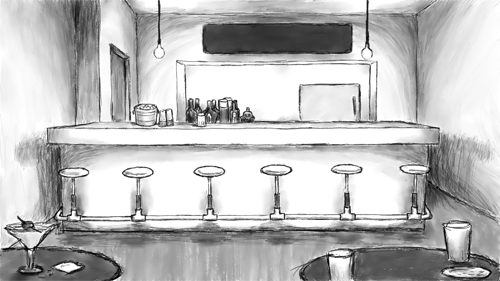Spring Cleaning and a Post-mortem
For Emery was launched about a week ago to no fanfare, and barely a reaction from myself, the sole developer of the interactive novel. What went wrong?

January 20, 2018. The date was a deliberate one so that it would avoid any major game releases for the year. It would be a week after the Consumer Electronics Show where most tech journalists would flock with raving reviews of the latest gadgets. A day before the launch date, Vesta would become available, and some 700 people would buy it according to Steamspy numbers (as of 26 Jan). A week after would be the Taipei Game Show where game journalists would flock with raving previews of the latest indie game, mobile game, and other AAA releases that would dominate the Asian market. Beyond that, The Wandering Ben’s A Case of Distrust would launch on February 9.
On hindsight, the hype before and after those dates would overshadow a tiny launch like mine. That should have been the first indication that my sales and marketing plans have been severely lacking. In my impatience to get this over and done with, I have made the mistake that would send a product to an early death.
As the packages were released on GameJolt and itch.io, I was expecting to feel relief, or some semblance of a positive emotion. Instead, nothing. Nothing came from the outside world, and nothing came out from me.
For someone who is candid about expressing emotions ranging from utter disdain to absolute joy, my reaction, or lack thereof, was puzzling. Maybe there’s a lingering downer of not launching to any press coverage, neutralised by the positive fact that I’ve finished my first project, alone. Maybe I was drowned in my elation of securing a better job and finally quitting a toxic company that has left me paranoid about their potential invocation of the non-compete clause, and it overshadowed the supposed joy that would be derived from launching my pet project. Maybe the idea of spreading myself to cover every single role as an indie developer excited and frustrated me — I could do everything on my own terms, but I couldn’t give my 100% for each component. The reaction was a result of feeling both “done!”, and “done…”.
And after all this, it’s even more maddening to know that I still don’t know what my real strengths are in the game development process. The whole process felt like it was made by your standard ‘Bsian’, not an ‘Asian’, let alone the superstar ‘A+sian’. This is probably where it would be helpful for user reviews to come in and point out which parts stood out, and which parts were flawed.
Nevertheless, here are some things that could’ve been improved even though I didn’t know where my strengths are:
Lack of social media presence
This should have been obvious. I had been managing many different Facebook pages with my day job and volunteer work, and also paranoid about my ex-colleagues linking up my gamedev identity with my day job’s identity. Circumstances aside, a dedicated Facebook page would have been a great feedback platform and a community builder. No amount of posting on TIGSource would allow for that kind of undivided attention.Unpolished marketing assets
Despite sending out personal emails to some targeted journalists (stuff like noticing which game they’ve covered before and themes that they would be interested in is pretty standard practice in cold emails and PR), only Warp Door picked it up and featured it during For Emery’s Early Access phase. December is a pretty bad time to try and get eyes on a small piece of work, and it’s especially so when I have relied on my writing prowess rather than letting visual elements speak. Attention spans are precious resources.An uninteresting title screen
Another project killer that I didn’t realise until it was too late. Initially, I thought that a minimalist title screen would pique interest and create a solemn mood immediately. But as marketing material, it is seen as an insignificant piece of work amidst GIFs of game mechanics at work.Giving the game away early on early access (?)
While opting for a transparent approach in giving updates to hold myself accountable, announcing that the game was available on early access may have killed off the game’s publicity early. But it seems that it’s a 50/50 chance here. Some developers have opted to not announce anything until they are ready with a launch date, whereas some have opted to announce and gather feedback early to incorporate improvements as they go along. My best guess would be that early access works best for games with constant content updates or a social/multiplayer functionality.
There could be more, but I’m drawing up blank at the moment.
Even then, there were some things in the process that went right:
Setting the core mechanics early
The point and click mechanic, in addition to the visual novel dialogue elements, gelled really well to create a Machinarium/Tim Burton-esque interactive novel. Prizing the mechanics above the original script has kept the workflow pretty smooth, and it made me willing to bend the script in more interesting ways. Nevertheless it has resulted in a cutscene that didn’t explain the fact that Death could shapeshift into a snake.

This background has saved me development hours.
Preparing art assets on the go
Keeping a to-do list of art assets should only serve as an overview rather than a huge tasklist to be wrangled immediately. This has helped me not feel overwhelmed by the scope of the project, and helped with the playtesting too. Another perk from this was that there were moments that felt like I had cut days out from the development grind when I realised I could reuse some art assets on a different level.Taking a coding class prior to development
Getting taught in C# in that class was a happy coincidence since I planned on using Unity, but the basics of knowing how to create functions and piecing logic together into something coherent has helped in bug-busting and problem solving during development.Knowing my upper limit/skill ceiling
Notwithstanding that I ended up not knowing where my strengths are after the project was completed, I knew where my upper limits were during the game development process, and took necessary breaks when needed. For skilled designers, they may have been able to churn out a VN/point-and-click adventure game with 15–20 minutes of gameplay in less than 6 months. But I had a day job, external projects, and other hobbies. While the flow of game development can be something addictive, I have set aside some time to be able to pursue other interests so that I don’t burnout and ensure that at least I’ve shipped a game.
Perhaps the most important takeaway from this entire process is that it isn’t enough to just have a playable build up and running, and patience is indeed a virtue I’m sorely lacking. However, launching For Emery has also freed up mental bandwidth to start prototyping a new game with a stronger cultural focus and adding twists into existing game mechanics.
With Lunar New Year in sight, families would spring clean to make their houses presentable for the festivities, and I did mine before setting myself up to type this post mortem. Upon excavating an old brochure on CIMMFest 2015, the mental images of the short film that inspired this story started flashing. Sandwiched between the pages of the brochure was a list of student films that were nominated and screened on a balmy Sunday afternoon. And there it was, the film that filled my brain with morbid what-if scenarios and made me miss my best friend (who was not in the same country at that time), and the film which I casted my audience choice vote.
I hope you would enjoy the film as much as I did:
This is a repost from my Medium account. For Emery can be bought for USD$3 at GameJolt and itch.io.
Read more about:
BlogsAbout the Author(s)
You May Also Like







.jpeg?width=700&auto=webp&quality=80&disable=upscale)








